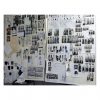Warning: Undefined variable $listtag in /home/storage/752/3595752/user/htdocs/wp-content/plugins/image-gallery-reloaded/image-gallery-reloaded.php on line 202
Deprecated: preg_replace(): Passing null to parameter #3 ($subject) of type array|string is deprecated in /home/storage/752/3595752/user/htdocs/wp-includes/formatting.php on line 4810
Material research, theme definition, order placement, delivery dates… The collection development goes way beyond drawing beautiful sketches (by the way, an uncommon task in a designer’s everyday real life) and it is one of the crucial stages to be sorted out as it is linked to internal and external factors that can jeopardize the whole business.
Let’s talk it through! The start point is the collection research: from the theme to textiles, including tools, accessories and colour palette. Creating a moodboard and write some sentences with main ideas are very helpful at this moment. From there, it’s time to streamline how many pieces will be developed and how they are going to be coordinated. Having the advice of a buyer or a merchandiser can work wonders to avoid overproduction as they have trained eyes to analyse the market. Point to consider: how to avoid waste of material? Why not investigate and invest in upcycling programs? By the way, it’s never late to make an extra effort to be an environmental conscious company.
In parallel to those steps, focus in the product-mix offer. It’s really important to have a coordinated collection, with colours and prints that “talk” with each other, so the client will always have options to build different looks or to buy something that is complementary to other (hello, link selling!). Another important issue: cash cow items. They are the key products to guarantee revenues, usually with a low cost and high margin. You can offer them in every collection, with maybe a few tweaks. T-shirts, tops, scarves and small leather goods are the most popular.
When the development is finished, you are ready to review the calendar and organize dates to take orders from wholesale and/or place orders to retail and set delivery time. Focus on special dates (Christmas, Mother’s Day, Valentine’s Day, Black Friday) and plan carefully what is going to be offered. Last but not least: sales season. As the practice of reducing prices throughout the season is becoming more and more common, pay extra attention to this and define the most convenient dates to your business. Don’t fall in the trap of following everybody else, since what’s good for the competition is not necessarily good for you!
In the next post: marketing and communication. How to promote your brand in the most cost-effective way?
Rewinding the series:


